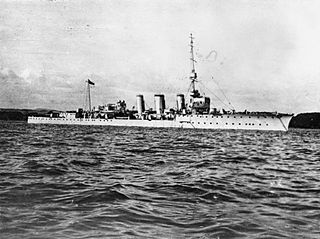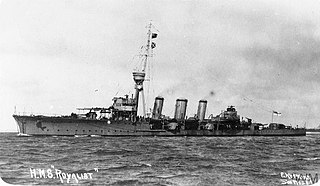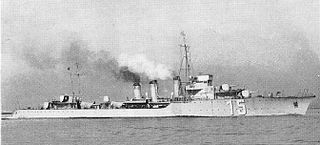
HMS Queen Mary was the last battlecruiser built by the Royal Navy before the First World War. The sole member of her class, Queen Mary shared many features with the Lion-class battlecruisers, including her eight 13.5-inch (343 mm) guns. She was completed in 1913 and participated in the Battle of Heligoland Bight as part of the Grand Fleet in 1914. Like most of the modern British battlecruisers, the ship never left the North Sea during the war. As part of the 1st Battlecruiser Squadron, Queen Mary attempted to intercept a German force that bombarded the North Sea coast of England in December 1914, but was unsuccessful. The ship was refitting in early 1915 and missed the Battle of Dogger Bank in January, but participated in the largest fleet action of the war, the Battle of Jutland in mid-1916. She was hit twice by the German battlecruiser Derfflinger during the early part of the battle and her magazines exploded shortly afterwards, sinking her with the loss of more than 98 percent of the ship’s complement.

HMS Colossus was the lead ship of her class of two dreadnought battleships built for the Royal Navy at the end of the first decade of the 20th century. She spent her whole career assigned to the Home and Grand Fleets, often serving as a flagship. Aside from participating in the Battle of Jutland in May 1916 and the inconclusive action of 19 August, her service during World War I generally consisted of routine patrols and training in the North Sea. Colossus was the only dreadnought from the main body of the Grand Fleet to be hit during the Battle of Jutland, although she suffered only minor damage. The ship was deemed obsolete after the war and was reduced to reserve and then became a training ship. Colossus was hulked in 1923 and sold for scrap in 1928.

The Arethusa-class cruisers were a class of eight oil-fired light cruisers of the Royal Navy all ordered in September 1912, primarily for service in the North Sea. They had three funnels with the middle one somewhat larger in diameter than the others. All served in the First World War. They were found to be very cramped internally.

HMS Castor was one of the Cambrian subclass of the C class of light cruisers. She saw service during the First World War and the Russian Civil War.

HMS Calliope was a C-class light cruiser of the Royal Navy under construction at the outbreak of the First World War. Both Calliope and her sister ship Champion were based on the earlier cruiser Caroline. They were effectively test ships for the use of geared turbines which resulted in the one less funnel. They also received slightly thicker armour. They led into the first of the Cambrian subclass.

HMS Caroline is a decommissioned C-class light cruiser of the Royal Navy that saw combat service in the First World War and served as an administrative centre in the Second World War. Caroline was launched and commissioned in 1914. At the time of her decommissioning in 2011 she was the second-oldest ship in Royal Navy service, after HMS Victory. She served as a static headquarters and training ship for the Royal Naval Reserve, based in Alexandra Dock, Belfast, Northern Ireland, for the later stages of her career. She was converted into a museum ship. From October 2016 she underwent inspection and repairs to her hull at Harland and Wolff and opened to the public on 1 July 2017 at Alexandra Dock in the Titanic Quarter in Belfast.

HMS Swift was a unique destroyer leader designed and built for the Royal Navy prior to World War I, another product of Admiral "Jackie" Fisher's relentless quest for speed. The class was envisioned as a large ocean-going destroyer, capable of both the usual destroyer requirements and of high-speed scouting duties for a major fleet.

HMS Fortune was an Acasta-class destroyer, and the twenty-first ship of the Royal Navy to bear the name. She was launched in 1913 and was sunk at the Battle of Jutland in 1916.

HMS Hydra was one of 20 Acheron-class destroyers built for the Royal Navy in the 1910s. Completed in 1912, the ship participated in World War I and was sold for scrap in 1921.

HMS Nottingham was a Town-class light cruiser built for the Royal Navy just before World War I. She was one of three ships of the Birmingham sub-class and was completed in early 1914. The ship was assigned to the 1st Light Cruiser Squadron (LCS) of the Home and Grand Fleets for her entire career. Nottingham participated in most of the early fleet actions, including the battles of Heligoland Bight, Dogger Bank, and Jutland, helping to sink several German ships during the battles. The ship was sunk by the German submarine U-52 during the Action of 19 August 1916.

HMS Cordelia was a C-class light cruiser built for the Royal Navy during World War I. She was one of six ships of the Caroline sub-class and was completed at the beginning of 1915. The ship was assigned to the 1st and 4th Light Cruiser Squadrons (LCS) of the Grand Fleet for the entire war and played a minor role in the Battle of Jutland in mid-1916. Cordelia spent most of her time on uneventful patrols of the North Sea. She served as a training ship for most of 1919 before she was recommissioned for service with the Atlantic Fleet in 1920. The ship was placed in reserve at the end of 1922 and was sold for scrap in mid-1923.

HMS Inconstant was one of eight Arethusa-class light cruisers built for the Royal Navy in the 1910s. She fought in the First World War, participating in the Battle of Jutland. Following the war, she was scrapped.

HMS Phaeton was one of eight Arethusa-class light cruisers built for the Royal Navy in the 1910s. She fought in the First World War, participating in the Battle of Jutland. Following the war, she was scrapped.

HMS Royalist was one of eight Arethusa-class light cruisers built for the Royal Navy in the 1910s. She fought in the First World War, participating in the Battle of Jutland. Following the war, she was scrapped.

HMS Falmouth was a Town-class light cruiser built for the Royal Navy during the 1910s. She was one of four ships of the Weymouth sub-class. The ship was initially assigned to the Atlantic Fleet upon completion in 1911, but was reduced to reserve in mid-1913. When the First World War began in 1914, Falmouth was transferred to the 1st Light Cruiser Squadron (LCS) of the Grand Fleet and then the 3rd Light Cruiser Squadron at the end of the year. The ship participated in most of the early fleet actions, including the Battles of Heligoland Bight, Dogger Bank, and Jutland, but was only seriously engaged in the latter. She was torpedoed and sunk off Flamborough Head, Yorkshire by German submarines during the action of 19 August 1916.

HMS Druid was one of 20 Acheron-class destroyers built for the Royal Navy during the 1910s. Completed in 1912 the ship served during World War I and was sold for scrap in 1921.
HMS Onslow was an Admiralty M-class destroyer built for the Royal Navy during the First World War. She took part in the Battle of Jutland in 1916 and was sold for scrap in 1921.

HMS Lynx was one of 20 Acasta-class destroyers built for the Royal Navy in the 1910s. Completed in 1914 she saw active service in the First World War.

Tramontane was a Bourrasque-class destroyer built for the French Navy during the 1920s.

Tornade was a Bourrasque-class destroyer built for the French Navy during the 1920s.



















